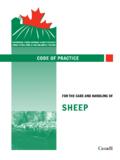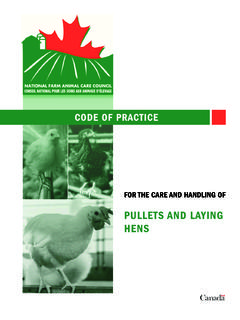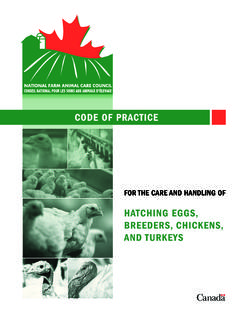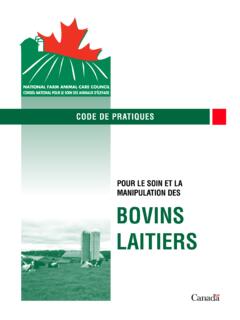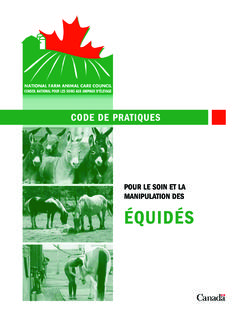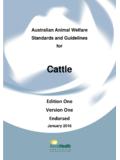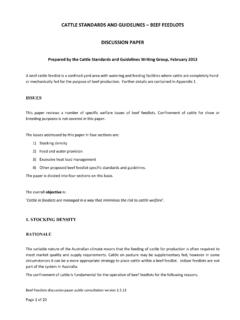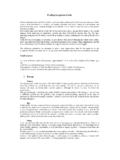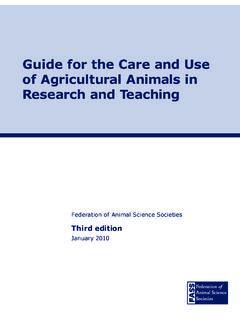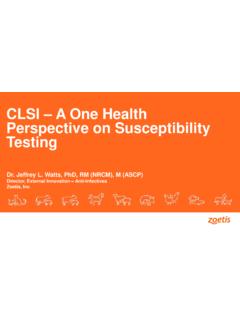Transcription of FOR THE CARE AND HANDLING OF BEEF CATTLE
1 FOR THE care AND HANDLING OFBEEF CATTLECODE OF PRACTICECODE OF PRACTICE FOR THE care AND HANDLING OF beef CATTLE - 2013iiISBN 978-0-9920910-0-2 (book) ISBN 978-0-9920910-2-6 (electronic book text)Available from: Canadian Cattlemen s Association 180, 6815 8th Street NE, Calgary AB T2E 7H7 CANADA Telephone: (403) 275-8558 Fax: (403) 274-5686 Website: Email: For information on the Code of Practice development process contact: National Farm Animal care Council (NFACC) Email: Website: Also available in French Copyright is jointly held by the Canadian Cattlemen s Association and the National Farm Animal care Council (2013)This publication may be reproduced for personal or internal use provided that its source is fully acknowledged. However, multiple copy reproduction of this publication in whole or in part for any purpose (including but not limited to resale or redistribution) requires the kind permission of the National Farm Animal care Council (see for contact information).
2 AcknowledgmentFunding for this project has been provided by Agriculture and Agri-Food Canada through the Agricultural Flexibility Fund, as part of Canada s Economic Action contained in this publication is subject to periodic review in light of changing practices, government requirements and regulations. No subscriber or reader should act on the basis of any such information without referring to applicable laws and regulations and/or without seeking appropriate professional advice. Although every effort has been made to ensure accuracy, the authors shall not be held responsible for loss or damage caused by errors, omissions, misprints or misinterpretation of the contents hereof. Furthermore, the authors expressly disclaim all and any liability to any person, whether the purchaser of the publication or not, in respect of anything done or omitted, by any such person in reliance on the contents of this image copyrights: Wanda Knoss (top photo) and John Campbell (bottom photo)CODE OF PRACTICE FOR THE care AND HANDLING OF beef CATTLE - 20131 Table of ContentsPreface.
3 3 Introduction ..5 Animal Protection from Extreme Weather .. High Temperature and Humidity .. Extreme Cold .. Facilities for All CATTLE .. Additional Facilities for Calving Cows ..9 Feed and Nutrition and Feed Management .. Water ..12 Animal Herd Health Management .. Sick, Injured and Cull CATTLE .. Health Conditions Related to Feedlot CATTLE .. Managing Risk of Bovine Respiratory Disease .. Lameness .. Nutritional Disorders Associated with High Energy Feeding .. Buller-Steer Syndrome .. Managing Pregnant Heifers in the Feedlot .. Safety and Emergencies ..18 Animal HANDLING and Moving CATTLE .. Reproduction and Calving Management .. Colostrum Management .. Identification .. Disbudding and Dehorning .. Castration.
4 Weaning .. Predator Control .. Tail Docking .. Pre-Transport Decision Making and Preparation for Transport .. Arranging Transport .. Loading and Receiving ..28On-Farm Euthanasia and Culling Decisions .. Methods of On-Farm Euthanasia .. Confirmation of Insensibility and Death ..32 Section 1 Section 2 Section 3 Section 4 Section 5 Section 6 CODE OF PRACTICE FOR THE care AND HANDLING OF beef CATTLE - 20132 References ..33 Glossary ..36 Appendices:Appendix A - Body Condition Scoring ..42 Appendix B - Nutrient Requirement Guidelines for beef Cows and Growing beef CATTLE ..45 Appendix C - Calving: When and How to Help ..46 Appendix D - Transport Decision Tree ..48 Appendix E - Lameness Descriptions Rendering Animals Compromised or Unfit for Transport.
5 49 Appendix F - Euthanasia - Secondary Kill Steps: Bleeding Out and Pithing ..50 Appendix G - Resources for Further Information ..52 Appendix H - Participants ..55 Appendix I - Summary of Code Requirements ..56 CODE OF PRACTICE FOR THE care AND HANDLING OF beef CATTLE - 20133 PrefaceThe National Farm Animal care Council (NFACC) Code development process was followed in the development of this Code of Practice. This Code of Practice for the care and HANDLING of beef CATTLE replaces its predecessor developed in 1991 and published by Agriculture Canada. The NFACC Code development process aims to: link Codes with science ensure transparency in the process include broad representation from stakeholders contribute to improvements in farm animal care identify research priorities and encourage work in these priority areas write clearly to ensure ease of reading, understanding and implementation provide a document that is useful for all stakeholders.
6 The Codes of Practice are nationally developed guidelines for the care and HANDLING of farm animals. They serve as our national understanding of animal care requirements and recommended practices. Codes promote sound management and welfare practices for housing, care , transportation and other animal husbandry practices. Codes of Practice have been developed for virtually all farmed animal species in Canada. NFACC s website provides access to all currently available Codes ( ).The Codes of Practice are the result of a rigourous Code development process, taking into account the best science available for each species, compiled through an independent peer-reviewed process, along with stakeholder input. The Code development process also takes into account the practical requirements for each species necessary to promote consistent application across Canada and ensure uptake by stakeholders resulting in beneficial animal outcomes.
7 Given their broad use by numerous parties in Canada today, it is important for all to understand how they are intended to be - These refer to either a regulatory requirement, or an industry imposed expectation outlining acceptable and unacceptable practices and are fundamental obligations relating to the care of animals. Requirements represent a consensus position that these measures, at minimum, are to be implemented by all persons responsible for farm animal care . When included as part of an assessment program, those who fail to implement Requirements may be compelled by industry associations to undertake corrective measures, or risk a loss of market options. Requirements also may be enforceable under federal and provincial regulation. Recommended Practices - Code Recommended Practices may complement a Code s Requirements, promote producer education and can encourage adoption of practices for continuous improvement in animal welfare outcomes.
8 Recommended Practices are those which are generally expected to enhance animal welfare outcomes, but failure to implement them does not imply that acceptable standards of animal care are not met. Broad representation and expertise on each Code Development Committee ensures collaborative Code development. Stakeholder commitment is key to ensure quality animal care standards are established and implemented. CODE OF PRACTICE FOR THE care AND HANDLING OF beef CATTLE - 20134 This Code represents a consensus amongst diverse stakeholder groups. Consensus results in a decision that everyone agrees advances animal welfare but does not imply unanimous endorsement of every aspect of the Code. Codes play a central role in Canada s farm animal welfare system as part of a process of continuous improvement.
9 As a result, they need to be reviewed and updated regularly. Codes should be reviewed at least every five years following publication and updated at least every ten key feature of NFACC s Code development process is the Scientific Committee. It is widely accepted that animal welfare codes, guidelines, standards or legislation should take advantage of the best available research. A Scientific Committee review of priority animal welfare issues for the species being addressed provided valuable information to the Code Development Committee in developing this Code of Practice. The Scientific Committee report is peer reviewed and publicly available, enhancing the transparency and credibility of the Code of Practice for the care and HANDLING of beef CATTLE : Review of scientific research on priority issues developed by the beef CATTLE Code of Practice Scientific Committee is available on NFACC s website ( ).
10 Preface (continued)CODE OF PRACTICE FOR THE care AND HANDLING OF beef CATTLE - 20135 IntroductionIn 1980, the Canadian Federation of Humane Societies began coordinating the process of developing Codes of Practice for all livestock species. In 1991, the Recommended Code of Practice for the care and HANDLING of Animals - beef CATTLE was developed from an original working draft contracted by the Ontario Cattlemen s Association to Dr. Frank Hurnik, Professor, Poultry and Animal Science, University of Guelph, Ontario. This draft was then submitted to all of the Canadian Cattlemen s Association s (CCA) provincial associations for review and input. Through agreement between the CCA and the Canadian Federation of Humane Societies and Agriculture Canada, a review committee chaired by Dr.


